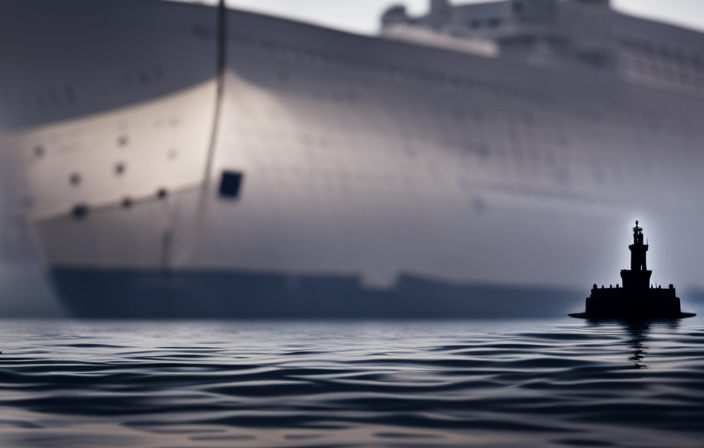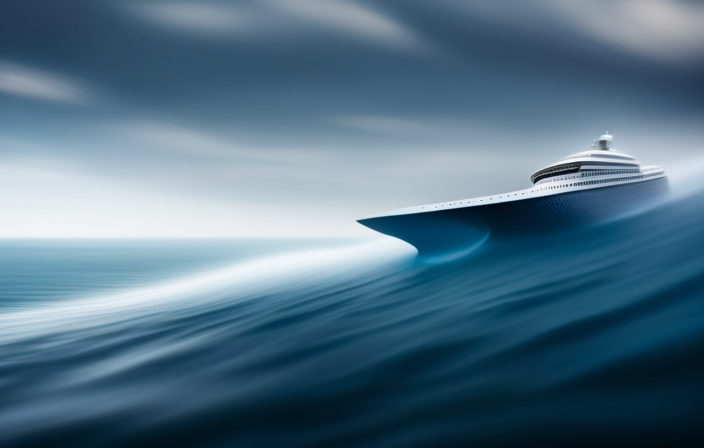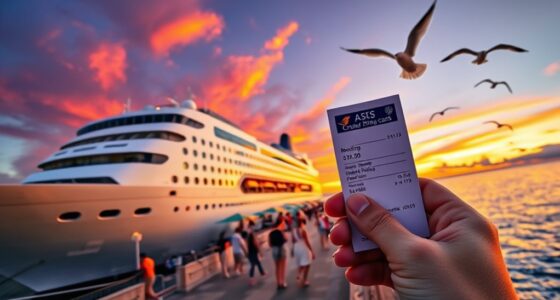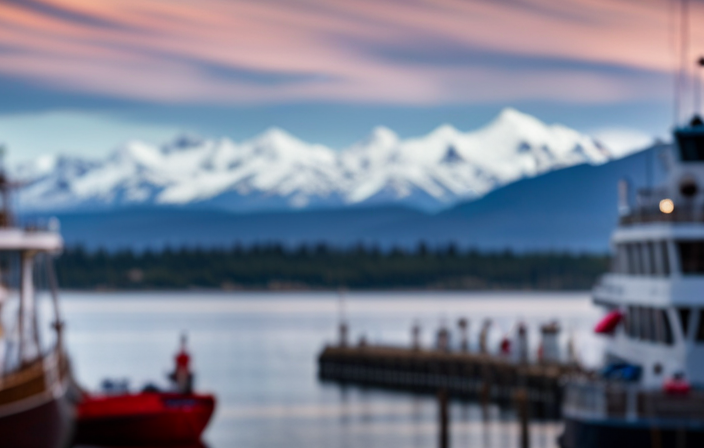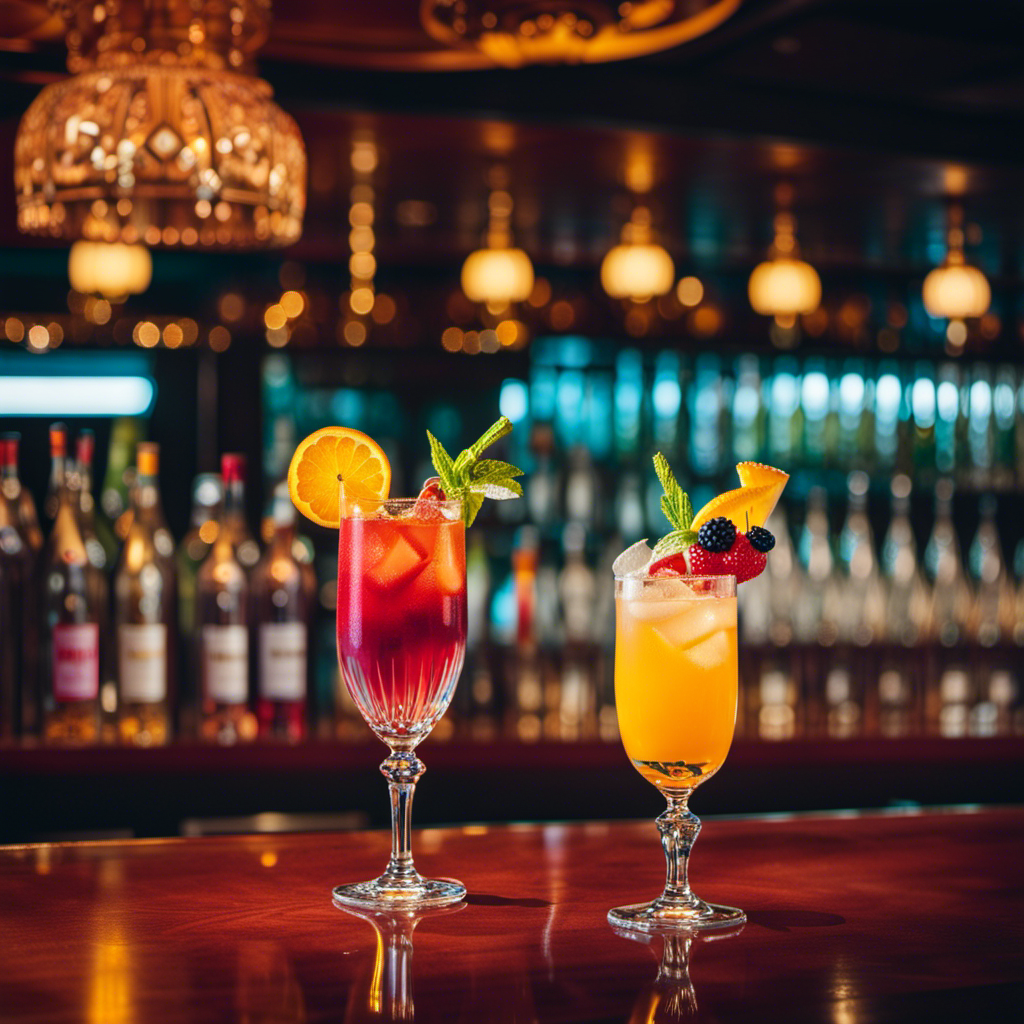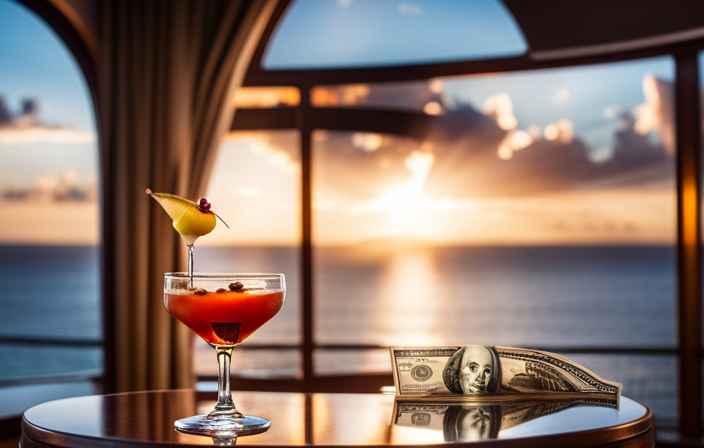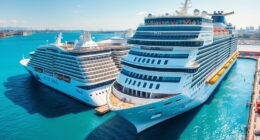On the shore, my gaze spans the vast expanse of the ocean, as my mind drifts to a crucial evening over a century ago. The Titanic, a grand vessel deemed unsinkable, met its end in the icy waters beneath. This story has captivated numerous people, including me.
But how does the size of the Titanic compare to the modern cruise ships that grace our seas today?
In this article, we will delve into the astonishing dimensions of the Titanic and explore how it measures up against its contemporary counterparts. From the evolution of cruise ship design to the behind-the-scenes operations and logistics, we will uncover the secrets of these floating behemoths.
Additionally, we will examine the safety and security measures implemented on modern cruise ships, especially in light of recent events such as the impact of COVID-19 on the industry.
Join me on this voyage of discovery, as we navigate through the legacy of the Titanic and witness the remarkable evolution of cruise ship engineering.
Key Takeaways
- The Titanic was significantly smaller than modern cruise ships, with a length of 882 ft 9 in compared to cruise ships that can be up to 1,188 ft long.
- The Titanic had a capacity of over 2,400 passengers and crew members, while modern cruise ships can accommodate over 6,000 passengers and 2,000 crew members.
- Modern cruise ships offer a wide range of amenities and luxury features, including multiple restaurants, pools, theaters, and shopping malls, which were not available on the Titanic.
- Sustainability and eco-friendly practices are a priority in modern cruise ship design, with advanced propulsion systems, alternative fuels, and reduced emissions being implemented to minimize environmental impact.
The Astonishing Dimensions of the Titanic
You won’t believe the astonishing dimensions of the Titanic, it was way bigger than you can even imagine! This engineering marvel was a true testament to the ambition and skill of its creators.
The Titanic measured an astounding 882 feet and 9 inches long, making it one of the largest ships of its time. It had a width of 92 feet and 6 inches, and a height of 175 feet from keel to the top of its funnels.
The ship weighed a staggering 46,328 tons and could accommodate over 2,400 passengers and crew members. Its sheer size and grandeur were unmatched, making it the epitome of luxury and extravagance.
Transitioning into comparing the Titanic to modern cruise ships, it’s remarkable to see how far we’ve come in terms of size and technology.
Comparing the Titanic to Modern Cruise Ships
When it comes to sizes of ocean liners, one cannot help but marvel at the sheer magnitude of the Titanic in contrast to its contemporary counterparts. The evolution of maritime technology has led to the construction of modern cruise ships that are significantly larger than the Titanic.
Today’s cruise ships can be over three times the length and twice the height of the Titanic. These modern giants can accommodate thousands of passengers and offer a vast array of amenities, from multiple restaurants and pools to theaters and shopping malls.
However, size is not the only factor that sets modern cruise ships apart. The role of luxury has become paramount in the design of these ships, with extravagant suites, gourmet dining options, and world-class spas.
With this in mind, the Titanic’s place in maritime history is truly unparalleled.
The Titanic’s Place in Maritime History
The Titanic’s legacy in maritime history remains unmatched due to its unparalleled role in shaping the future of ocean travel. Its tragic sinking in 1912 not only marked one of the deadliest maritime disasters but also sparked a cultural fascination that continues to captivate people to this day.
Its sheer size, luxurious amenities, and advanced technologies at the time set new standards for the industry. The Titanic’s impact on maritime safety regulations led to significant improvements in ship design and emergency procedures. Its demise served as a wake-up call, prompting the establishment of international organizations like the International Ice Patrol and the International Convention for the Safety of Life at Sea.
As we delve into the subsequent section about the evolution of cruise ship design, it becomes evident that the Titanic’s influence transcends time and continues to shape the industry.
Evolution of Cruise Ship Design
When discussing the evolution of cruise ship design, it’s important to consider the advancements in technology and engineering that have shaped the industry.
From the use of advanced materials to the implementation of sophisticated navigation systems, modern cruise ships are a testament to human ingenuity.
Furthermore, the increase in passenger amenities and entertainment options has transformed the cruising experience, catering to the diverse preferences and desires of travelers.
Lastly, environmental considerations have become a crucial aspect of modern cruise ship design, with a focus on reducing carbon emissions and implementing sustainable practices to protect the delicate ecosystems they visit.
Advancements in Technology and Engineering
With its massive size and cutting-edge technology, modern cruise ships easily dwarf the Titanic. Advancements in propulsion systems have revolutionized the way these ships are powered. The use of diesel-electric engines and gas turbines allows for greater fuel efficiency and reduced emissions compared to the coal-fired engines of the Titanic.
Automation and artificial intelligence have also played a significant role in improving the efficiency and safety of modern cruise ships. From navigational systems to engine control, these advancements have streamlined operations and reduced the reliance on human intervention. This has led to smoother sailing and a lower risk of accidents.
Moving forward, the increase in passenger amenities and entertainment has become a focal point for cruise ship designers. From water parks to Broadway-style shows, modern cruise ships aim to provide a memorable and enjoyable experience for passengers.
Increase in Passenger Amenities and Entertainment
Passenger amenities and entertainment on today’s cruise ships have reached unprecedented levels, creating an unforgettable and enjoyable experience for all. One of the notable advancements in modern cruise ships is the increase in onboard dining options. From upscale restaurants with celebrity chefs to casual buffet-style eateries, cruise ships now offer a wide variety of culinary experiences to cater to every palate.
Additionally, the evolution of onboard entertainment has transformed the cruising experience. Passengers can enjoy Broadway-style shows, live music performances, comedy clubs, and even movie theaters onboard. The availability of these entertainment options ensures that there is never a dull moment during the voyage.
As we transition into the subsequent section about environmental considerations in modern cruise ships, it is important to note that these advancements in passenger amenities and entertainment have been accompanied by a growing awareness of sustainability and eco-friendly practices in the industry.
Environmental Considerations in Modern Cruise Ships
One aspect that cannot be overlooked is the emphasis on eco-friendly practices and sustainability in the cruise industry today. Cruise lines are taking significant green initiatives to minimize their environmental impact. From waste management to energy efficiency, modern cruise ships are designed with the latest technologies to reduce their carbon footprint.
To give you an idea of the environmental considerations in modern cruise ships, let’s take a look at a comparison between the Titanic and a typical modern cruise ship:
| Aspect | Titanic | Modern Cruise Ship |
|---|---|---|
| Waste Management | Limited recycling options | Comprehensive recycling programs |
| Energy Efficiency | Coal-powered engines | Advanced propulsion systems and alternative fuels |
These improvements in waste management and energy efficiency demonstrate the commitment of the cruise industry to sustainable practices. This shift towards eco-friendly operations not only benefits the environment but also enhances the overall cruise experience for passengers.
Transitioning into the subsequent section about the largest cruise ships in the world, it is fascinating to see how these environmental considerations have been incorporated alongside advancements in size and amenities.
The Largest Cruise Ships in the World
Imagine yourself standing next to the largest cruise ship in the world, feeling tiny as it towers over you. The construction of these massive vessels is a testament to the technological advancements in cruise ships. These behemoths can stretch up to 1,188 feet long, accommodating over 6,000 passengers and 2,000 crew members.
They boast an impressive array of amenities, including multiple pools, theaters, restaurants, and even ice skating rinks. With a gross tonnage of over 225,000, these ships are truly engineering marvels. Their size allows for stability and comfort, even in rough seas.
As you gaze up at the towering structure, it’s hard to comprehend the sheer scale and complexity of these floating cities. They represent the pinnacle of modern cruise ship design and innovation.
Now, let’s explore what the future holds for these incredible vessels.
The Future of Cruise Ship Design and Innovation
As you stand in awe of these colossal floating wonders, you can’t help but marvel at the boundless possibilities that lie ahead for the future of cruise ship design and innovation.
The future of sustainability in the cruise industry is promising, with cruise lines exploring ways to reduce their environmental impact. Innovative technologies are being developed to harness renewable energy sources, such as solar and wind power, to propel these massive vessels. Additionally, advanced waste management systems are being implemented to minimize pollution and protect marine life.
The future also holds exciting prospects for passenger comfort and entertainment, with the integration of virtual reality experiences and cutting-edge amenities. As the industry continues to evolve, the future of cruise ship design promises a greener, more immersive, and unforgettable experience for travelers.
Transitioning into the subsequent section about ‘behind the scenes: operations and logistics of modern cruise ships,’ we delve into the intricate workings that make these magnificent ships operate seamlessly.
Behind the Scenes: Operations and Logistics of Modern Cruise Ships
Operating and managing the intricate workings of these floating marvels requires a well-coordinated team, ensuring smooth logistics throughout the entire journey. To demonstrate the complexity of operations efficiency and crew management, let’s take a look at a 3×3 table highlighting key aspects:
| Aspects | Importance | Challenges |
|---|---|---|
| Guest satisfaction | High | Meeting diverse expectations, handling complaints |
| Food and beverage | Critical | Managing inventory, dietary restrictions |
| Onboard activities | Moderate | Scheduling, space utilization |
Efficiency in these areas directly impacts the overall experience for passengers. From ensuring prompt service to maintaining a variety of dining options, the crew’s ability to manage these operations is crucial. As we delve into the topic of safety and security measures on modern cruise ships, it is important to note that these aspects are closely intertwined, with efficient operations providing a solid foundation for ensuring a safe and secure environment for all on board.
Safety and Security Measures on Modern Cruise Ships
When it comes to safety and security on modern cruise ships, there are three key points to consider.
Firstly, emergency response and evacuation procedures are meticulously planned and practiced to ensure the safety of all passengers and crew members in the event of an emergency.
Secondly, surveillance and security systems are in place throughout the ship to monitor and prevent any unauthorized activities or potential threats.
Lastly, modern cruise ships comply with strict international regulations to ensure that they meet the highest standards of safety and security.
These measures combine to create a safe and secure environment for everyone on board.
Emergency Response and Evacuation Procedures
To ensure your safety during an emergency, it’s crucial to familiarize yourself with the evacuation procedures on modern cruise ships, especially when it comes to the Titanic’s size comparison.
Modern cruise ships are equipped with state-of-the-art emergency response training and procedures to handle any potential crisis. Crew members undergo rigorous training to ensure they’re well-prepared to handle emergency situations and efficiently guide passengers to safety.
Additionally, modern cruise ships have advanced surveillance systems and passenger accountability measures in place to quickly locate and assist individuals during an evacuation. These systems help ensure that every passenger is accounted for and no one’s left behind.
Understanding and following these evacuation procedures is essential for a safe and efficient evacuation process in the event of an emergency.
Transitioning into the subsequent section about surveillance and security systems, it’s important to note that these measures are just one part of the comprehensive safety and security protocols on modern cruise ships.
Surveillance and Security Systems
Passenger safety is ensured through advanced surveillance and security systems on board. These state-of-the-art surveillance technologies play a crucial role in maintaining a secure environment for all passengers.
Here are three key components of the surveillance and security systems on modern cruise ships:
-
CCTV Cameras: Numerous closed-circuit television cameras are strategically placed throughout the ship, monitoring public areas, corridors, and entry points. This comprehensive coverage allows for real-time monitoring and swift response to any suspicious activities.
-
Access Control Systems: Advanced security protocols are in place to control access to different areas of the ship. From keycards to biometric scanners, these systems ensure that only authorized individuals can enter restricted areas, enhancing overall safety.
-
Emergency Response Teams: Trained security personnel are stationed on board, ready to respond to any security threats or emergencies. They undergo rigorous training and are equipped with the necessary tools to handle various situations effectively.
With these surveillance technologies and security protocols in place, cruise ships comply with international regulations, providing passengers with a safe and secure environment throughout their voyage.
Compliance with International Regulations
For your safety, it’s crucial that cruise ships adhere to international regulations like a well-oiled machine, ensuring a smooth and secure voyage. These regulations encompass a wide range of safety measures that are designed to protect passengers, crew members, and the environment.
From the International Convention for the Safety of Life at Sea (SOLAS) to the International Maritime Organization (IMO) guidelines, these regulations set the standards for everything from emergency procedures to fire safety, navigation, and pollution prevention.
Cruise ships must undergo rigorous inspections to ensure compliance, including regular safety drills and audits. By adhering to these international regulations, cruise ships demonstrate their commitment to providing a safe and secure experience for everyone on board.
Transitioning into the subsequent section about the impact of COVID-19 on the cruise industry, it is important to consider how these regulations have been further strengthened in response to the pandemic.
The Impact of COVID-19 on the Cruise Industry
Amidst the COVID-19 pandemic, the cruise industry has suffered a significant blow, leaving many wondering about its future. The impact of quarantine measures has been immense, with cruise ships being quarantined due to outbreaks on board. This has not only led to a negative perception of the industry but has also resulted in a massive decline in bookings and revenue. The economic implications are staggering, with cruise lines reporting billions of dollars in losses and struggling to stay afloat.
Travel restrictions and lockdowns have prevented cruise ships from operating, resulting in empty ports and deserted ships.
The cancellation of cruises has not only affected the cruise lines themselves but also the countless businesses that rely on the industry, such as hotels, restaurants, and local tour operators.
The future of the cruise industry remains uncertain, with experts predicting a slow recovery as travelers prioritize safety and opt for alternative vacation options.
In conclusion, the COVID-19 pandemic has had a devastating impact on the cruise industry, causing widespread economic implications and uncertainty for its future.
Now let’s delve into the legacy of the Titanic and how cruise ships have evolved since then.
Conclusion: The Titanic’s Legacy and the Evolution of Cruise Ships
As I reflect on the legacy of the Titanic and the remarkable evolution of ocean liners, it’s fascinating to see how these majestic vessels have transformed over the years. The Titanic, once considered the epitome of luxury and size, now pales in comparison to modern cruise ships.
Today’s cruise ships are not only much larger, but they also boast a wide range of amenities and features that were unimaginable during the time of the Titanic. From multiple restaurants and bars, to sprawling water parks and theaters, modern cruise ships offer a plethora of entertainment options for passengers.
Furthermore, future trends in cruise ship design are focused on sustainability and eco-friendliness, with the incorporation of advanced technologies to reduce fuel consumption and minimize environmental impact.
The legacy of the Titanic lives on as a symbol of the past, while modern cruise ships continue to push the boundaries of innovation and luxury.
Frequently Asked Questions
How many passengers and crew members were aboard the Titanic?
There were a total of 20 lifeboats on the Titanic, which could accommodate approximately 1,178 people. In terms of passengers and crew members, there were approximately 2,224 individuals on board the Titanic.
What was the cost of building the Titanic?
The cost of building the Titanic was approximately $7.5 million, and it took about 3 years to construct. It was an expensive and time-consuming project, but the result was a magnificent and luxurious ship.
Did the Titanic have any sister ships?
The Titanic had two sister ships, the RMS Olympic and the HMHS Britannic. The Titanic’s legacy includes a major impact on maritime safety and the lessons learned from its tragic disaster.
How long did it take to build the Titanic?
The Titanic took approximately 2 years and 3 months to build. The construction process began on March 31, 1909, and the ship was completed on May 31, 1911.
How many lifeboats were on the Titanic and how many people did they accommodate?
The Titanic had a total of 20 lifeboats, each with a capacity of around 65 people. Their design was based on regulations at the time, which didn’t require enough lifeboats for all passengers.
Conclusion
In conclusion, the Titanic’s legacy looms large in maritime history, forever etched in our collective memory. As I reflect on the astonishing dimensions of this iconic ship, I can’t help but marvel at how far cruise ship design has come.
From the Titanic’s majestic presence to the behemoths of today, modern cruise ships have undergone a remarkable evolution. They have become floating cities, with advanced operations, stringent safety measures, and intricate logistics.
However, amidst all the progress, one cannot help but feel a sense of awe for the Titanic’s tragic fate, a reminder of the fragility and resilience of human endeavors.

